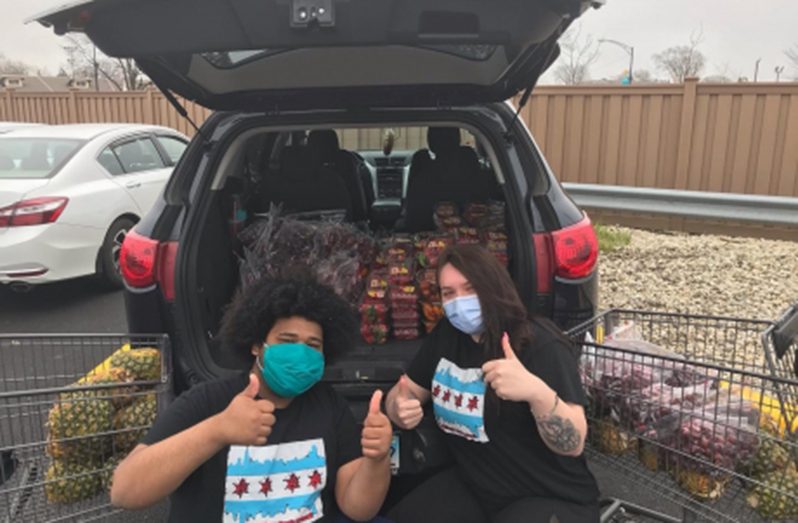–how Indigenous youth are tackling climate change, COVID-19 and other challenges with innovative solutions
(FAO) CHILDREN and youth are our future, and they are also our present. Innovative and adaptive by nature, youth are often the first to take on new technologies to tackle challenges or find solutions. This is particularly notable in Indigenous Peoples’ communities, which often face systematic marginalization, denial of their rights and destruction of their territories.
Indigenous Peoples are one of the most affected by climate change, yet are the people contributing the least to it. In fact, Indigenous Peoples’ food systems enhance biodiversity and mitigate the impacts of climate change.
For hundreds of years, they have developed ways of life and food systems based on observation and adaptation to environmental changes, creating exceptionally resilient societies.
Around the world, Indigenous youth are leading initiatives to address challenges by blending Indigenous Peoples’ knowledge and practices with new technologies and resourceful networks. In this way, Indigenous youth are able to navigate and combine traditional cultures with modern trends. This has been particularly evident throughout the COVID-19 pandemic during which they have created distribution services and adapted communication tools to help their communities stay safe and informed.
 The FAO publication Indigenous Youth as Agents of Change highlights six inspiring cases of youth led-actions to overcome COVID-19 and climate challenges.
The FAO publication Indigenous Youth as Agents of Change highlights six inspiring cases of youth led-actions to overcome COVID-19 and climate challenges.
Here are just three of these examples of these Indigenous youth-driven solutions:
CREATING AN INDIGENOUS DIGITAL NETWORK
Kipkandule Code Area (KCA) is a youth group consisting of 58 members and was founded in Kenya in 2018. They are made up of the Endorois Indigenous people, whose food and livelihoods systems rely on pastoralism, beekeeping, farming and fishing.
In addition to the challenges brought on by climate change impacts such as severe floods and prolonged droughts, the COVID-19 pandemic presented new ones. The KCA responded by creating a digital network for Endorois members in different areas to ensure community-wide access to updated COVID-19 information in their language of Mochongoi.
This solution exemplifies the benefits that communication technologies can have for communities to organize and care for common needs during public health emergencies. This youth group also raised money to repair roads destroyed during heavy rainfalls and floods. This allowed the community to maintain access to medical equipment and hygiene products during the pandemic and to ensure food availability in the markets.
OFFERING GARDENING BOXES AND MEDICAL EQUIPMENT
The Chi-Nations Youth Council was formed in 2012 and comprises a diverse group of Indigenous youth and adults in the Greater Chicago area. Its mission is to use awareness and education to create an open and supportive environment for native youth. During the COVID-19 pandemic, many people in urban Indigenous Peoples’ communities lost sources of income and struggled to afford nutritious food.
This prompted the Council to focus on improving food security and the well-being of native American communities in their region. The group provided seeds, soil and gardening boxes to 500 native Americans and the surrounding communities who can now plant herbs and vegetables in their home gardens.
When there was a lack of data collection tracking the impact of COVID-19 on native American communities in their area, the Council collected their own data to identify neighborhoods that needed medicines and medicinal equipment.
Building off these solutions developed by the Youth Council, FAO has disseminated these best practices on ways to support Indigenous Peoples’ communities during emergencies. For example, one approach is verifying that emergency supplies are culturally appropriate and respect dietary customs while promoting nutrition and health.
PROVIDING FOOD SERVICES FOR THE ELDERLY
Living in Siberia means being on the front line of climate change. The rate at which temperatures are rising here exceeds other regions around the world and, as a result, Siberia faces severe weather such as wildfires, dust storms and floods.
The Indigenous Peoples of the Oymyakon village are known as the Sakha people and they traditionally herd reindeers and horses. However, due to the dramatically warmer springtime weather, maintaining cattle farming and horse herding has become challenging. To address such challenges, young Indigenous mothers of Oymyakon founded the Kyubeye Youth group in 2017 to raise awareness of community issues at both the community and government level.
When COVID-19 hit in 2020, the Sakha people faced additional difficulties such as limited access to health and internet services. The elders in the communities especially struggled to stay food secure during this period. This prompted the youth group to provide food deliveries and grocery services for the elderly. The Indigenous youth hunters also shared their quarry (fish and ducks) with them and many others in vulnerable situations to ensure natural, nourishing foods during the lockdown.
The Kyubeye Youth group also translated the World Health Organization recommendations into the Sakha language and informed the villagers of them. This highlighted the need to help Indigenous Peoples’ communities gain access to technologies and translation of essential resources during emergencies.
Indigenous youth are leading their communities through times of hardship, finding innovative solutions that combine modern day technologies with their Indigenous practices, food and knowledge systems, languages and cultural values. Using technology, fundraising and distribution services, they find solutions to enhance food security within their communities and tackle climate-related challenges. FAO works with Indigenous Peoples communities to recognize, respect, document and promote their food and knowledge systems in finding solutions to today’s challenges, whether related to climate change, food insecurity or pandemics.




.png)









